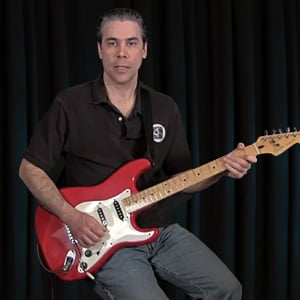Description
We identify the key signature by looking at all the chords in the progression over which you want to improvise. Write out all the notes in all the chords and see if you can build a scale. Let's use these chords for example: A major, D major, and E major. Take those and write out all the notes those chords contain:
A major: a, c-sharp, e
D major: d, f-sharp, a,
E major: e, g-sharp, b
Now put them in alphabetical order: a, b, c-sharp, d, e, f-sharp, g-sharp, a. Notice that is an A major scale. This is essentially what a key is. What "key a song is in" is which major (or minor) scale all (or most) of the notes in the song belong to (or the melody, riff, section of the song).
So, the first thing we need to do is be able to confidently play the A major scale in order to play the licks we'll build in this tutorial. Let's work on that now!
We're going to use the A major scale in two octaves in a lower register. And an octave higher in the higher register. So, let's practice it with a backing track. Don't worry if you can't play it all right away or very well. Right now we just want to start playing it in 2 different places on the fretboard to get used to the sound, feel and look of it.
Lesson Info
Tutorial Lessons
- Introduction
- Identifying The Key Signature
- Major Scale Play Along
- Building Phrases That Target Chord Tones
- Basic Melody Play Along
- Basic Melody An Octave Higher
- Octave Higher Basic Melody Play Along
- Adding a Slide To The Basic Melody
- Adding a Slide Play Along
- Adding a Slide An Octave Higher
- Slide an Octave Higher Play Along
- Adding a Bend To The Basic Melody
- Adding a Bend Play Along
- Adding a Bend An Octave Higher
- Bend an Octave Higher Play Along
- Conclusion
